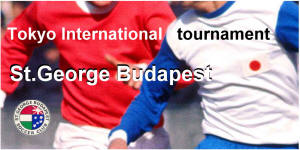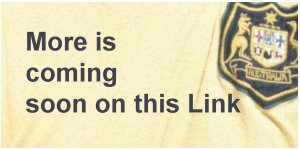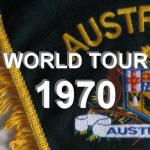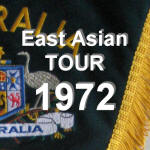|
|
Asia
has again proved a successful hunting ground for Australian Soccer. Six wins and a draw in
October’s 25-day tour of South East Asia enabled the
1972 Socceroos to repeat their
1967 performance of going through Asia undefeated. Australia since 1965 has played 37 matches in Asia for only four defeats, three of them in Cambodia in 1965 and against Israel in Tel Aviv in December 1969. The only other side ever to beat a touring Australian team was Hong Kong, 1:0 in November 1965. Australia’s Squad for the Asia Tour was: GOAL: Ron Corry and Jack Reilly. DEFENCE: George Harris, Bugsy Nyskohus, Bobby Hogg, Doug Utjesenovic, Peter Wilson (c), Manfred Schaefer. MIDFIELD: Ray Richards, Jim Rooney, Jim Mackay, Ray Baartz, John Warren, John McDonald. FORWARDS: Atti Abonyi, Terry Butler, Adrian Alston, Branco Buljevic, Max Tolson, Jim Armstrong. Coach: Rale Rasic Of the players originally invited George Keith, Billy Rogers, Alan Marnoch, John Watkiss and John Nyskohus did not make the tour for one reason or another. |
|
The 1972 Soccer tourists had to overcome four trying hurdles, any one of which could have proved fatal. The matches in Indonesia, South Vietnam and the Philippines were played in absolutely stifling heat, when even to bend over to tie one’s shoelaces resulted in flood of perspiration. Then, in South Korea, the temperature dropped sharply to icily cold, bitterly windy 38 degrees. Secondly, they went through a terrifying experience against an South Vietnam Under 23 Selection when a large section of crowed rushed the field when the game ended. Hundreds of riot police intervened to disperse the angry mob, but not before several players were hit by bottles, rocks, iron sticks, ice blocks and even petrol, which all but blinded one Australian official. On their way back to their hotel, after huddling in a dingy dressing room for 45 minutes while troops cleared surrounding streets, the tourist’s bus was stoned and windows shattered despite a military escort. Thirdly,
Australia faced determined, skilful and fit teams in the Indonesians, Vietnamese and South
Koreans, who had all prepared extensively for their matches against opponents whom they
regard as top Soccer country in the Asian region. And fourthly, the Socceroos invariably
came up against biased or inept referees, most of whom wouldn’t get a Second Division
ticket in Australia. |
|
|
To their credit, Rale Rasic’s 20-man squad took it all in their stride and clearly showed Australia is the best team in Asia-Oceania at the moment by dominating every match played. The Australians showed more aggression, physical strength and combinative ability than all their opponents. They played eye-catching football when allowed to – against South Vietnam, Indonesia and the Philippines – and fought desperately when forced to – for 25 minutes in the second half of the first match against South Korea. These two extremes in there repertoire lifted them above Indonesia, New Zealand, the Vietnamese, South Korea and the Philippines and showed Asia that Australia is still the team to beat in next year’s Asia-Oceania World Cup qualifying sup-groups. The tour started in Indonesia where they played a match against the Indonesian national side. Surprisingly, when the Australian squad arrived in steamy Djakarta, the Socceroos found out that they were branded as the underdogs. The players could not understand this, but in any case, they decided to teach the local team and their fans, a good lesson. Australia demolished their National team 4:1 in the Indonesian capital with goals from Buljevic (2), Baartz and Tolson. Two
days later the Australians played the old enemy New Zealand in a friendly in Djakarta. The
match was played in 36C heat with stifling humidity and the heat affected both sides.
|
|
|
Australia went to Saigon and played a friendly match against the South Vietnam under-23 side. The game ended in controversial circumstances where fans invaded the pitch upset at the hard physical play of the Australians. The Socceroos won 2:0, Branko Buljevic scored both goals. After the game, the Australians were pelted with bottles and rocks before Soldiers restored order and allowed the team to leave the field. This match was played as a warm-up to the game against the South Vietnam national side but after the controversy this match was under a cloud. The next match saw Australia return to the 'war zone' that was South Vietnam. This match was played two days after the crowd disturbance in the Australia versus South Vietnam under 23's and was in danger of being called off. Australia took to the field carrying a Vietnamese flag and messages of goodwill were played over the PA to defuse a tricky situation. Buljevic scored again and the Socceroos won 1:0. This was the last match ever played between the two countries, as soon after that, South Vietnam was to fall to the Communists.
Next stop was South Korea for two matches against the
national side. The first game was again marred by Australia’s poor finishing but the
1:1 draw meant that Australia kept their undefeated record on tour. Big Max Tolson scored
the winner. Australia had so many chances and the Green and Gold could have won by at
least three clear goals. The final match of the tour was against the Philippines in Manila. The Philippines side was completely outclassed by the Australians and they proved this point by slotting home six goals. Abonyi converted from the spot, and the goal opened the flood gates. Richards, Warren Buljevic, Butler and Utjesenovic scored the other goals. Australia finish the tour unbeaten. On their return to Sydney, the team Captain, Peter Wilson, said: “We have nothing to fear from the Asian nations, or from New Zealand.” The big win against the Philippines was a good way to celebrate the event. From now on, it would be a sprint to the finals in West Germany.
The Socceroos, led by Peter Wilson received a champagne
welcome from wives and friends at Sydney’s Mascot Airport on returning from their
Asian tour. Australian Soccer Federation President Sir Arthur George said that the tour
made possible by the money of four sponsors. The President introduced representatives of
the World Cup Consortium, whom presented their trophies: |
|
| more of this tour coming soon | |
|
|
|
 


 |
André Krüger™